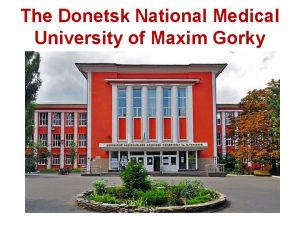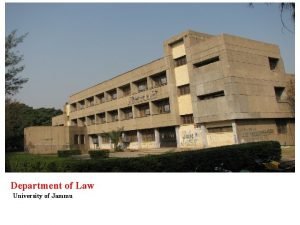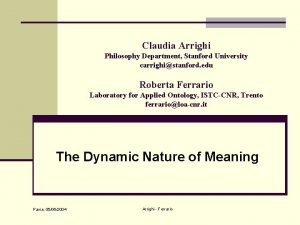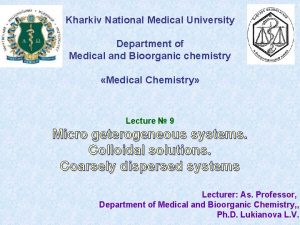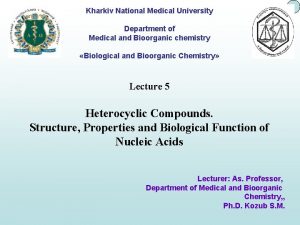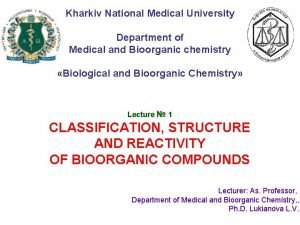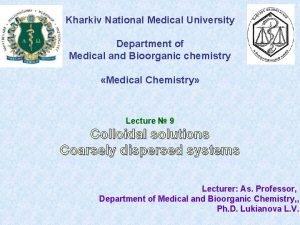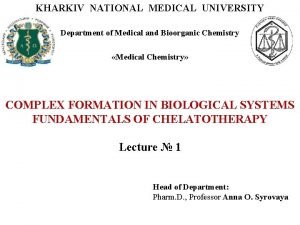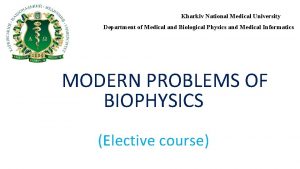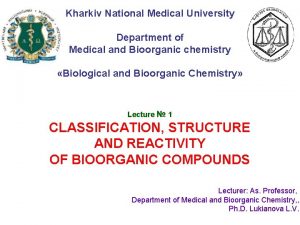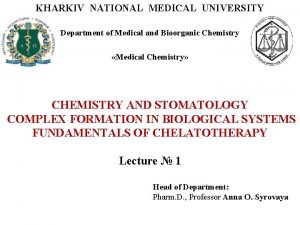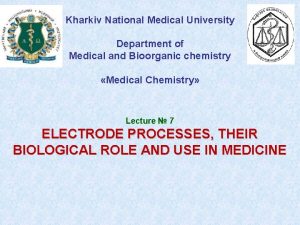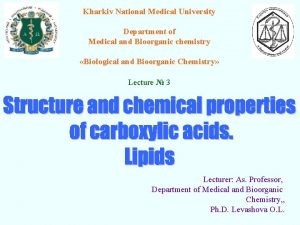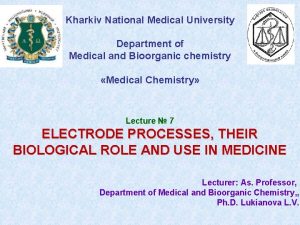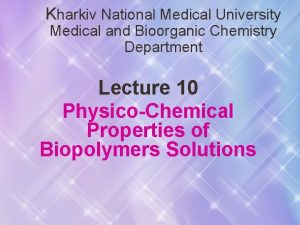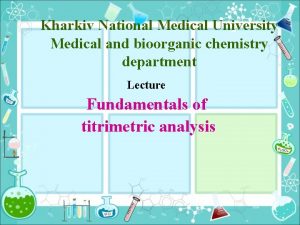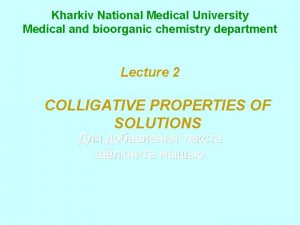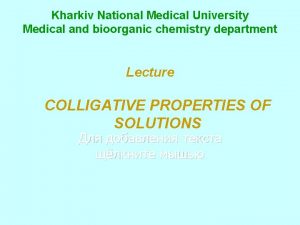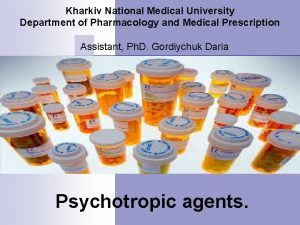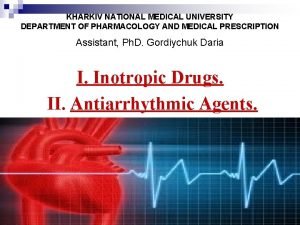KHARKIV NATIONAL MEDICAL UNIVERSITY Department of Medical and





![STRUCTURE OF COMPLEX COMPOUND complex ions of the outside sphere K 3[Fe(CN)6] complexing agent STRUCTURE OF COMPLEX COMPOUND complex ions of the outside sphere K 3[Fe(CN)6] complexing agent](https://slidetodoc.com/presentation_image/a83de8d67ab0c26ea58905d15ad51220/image-6.jpg)













![Stability of Complex Compounds. The instability constants Kinst: + Kinst [Ag ][NH 3 ]2 Stability of Complex Compounds. The instability constants Kinst: + Kinst [Ag ][NH 3 ]2](https://slidetodoc.com/presentation_image/a83de8d67ab0c26ea58905d15ad51220/image-20.jpg)






- Slides: 26

KHARKIV NATIONAL MEDICAL UNIVERSITY Department of Medical and Bioorganic Chemistry «Medical Chemistry» COMPLEX FORMATION IN BIOLOGICAL SYSTEMS FUNDAMENTALS OF CHELATOTHERAPY Lecture № 1 Head of Department: Pharm. D. , Professor Anna O. Syrovaya

PLAN OF LECTURE 1. Complex compounds (C. C. ) 2. Complexing agents. Ligands. Structure of C. C. Bonding in C. C. 3. Equilibria in the solution of C. C. Stability of C. C. 4. Classification of C. C. 5. Nomenclature C. C. (by IUPAC) 6. Structure and isomerism of C. C. 7. Complexonometry. Biocomplexes. Chelatotherapy.

We must to know: • The bulding of complex compounds (C. C. ) • The role of C. C. in the metabolism of the organism • The application of C. C. in medicine • Name the C. C. , nomenclature of C. C. , classification of C. C. • Biocomplexes • Complexonometry • Chelatotherapy

COMPLEX COMPOUNDS (COORDINATION COMPOUNDS) (C. C. ) are a special class of compounds, in which the central metal atom or ion is surrounded by oppositely charged ions or neutral molecules more than its normal valency. C. C. Present in the minerals plants animals Play many important functions In biological systems: iron Heme (hemoglobin) is coordination compound of cobalt Vitamin B 12 is coordination compound of magnesium Chlorophyll is coordination compound of

COORDINATION THEORY, 1893 one of the ions in a molecule generally a positively charged one occupies a central position ‒ is called a complexing agent or central ion. Alfred Werner (1866 -1919) Nobel Prise (1913) COMPLEX COMPOUNDS BY WERNER C. C. contains complex ion: a central atom or ion (metal) and ligands (neutral molecules, ions) [ central atom + ligands] - inner sphere of the complex (complex ion) TODAY Main valence - due to the formation of ionic and covalent bonds by the exchange mechanism Incidental valence - form a covalent bond by the donor-acceptor mechanism.
![STRUCTURE OF COMPLEX COMPOUND complex ions of the outside sphere K 3FeCN6 complexing agent STRUCTURE OF COMPLEX COMPOUND complex ions of the outside sphere K 3[Fe(CN)6] complexing agent](https://slidetodoc.com/presentation_image/a83de8d67ab0c26ea58905d15ad51220/image-6.jpg)
STRUCTURE OF COMPLEX COMPOUND complex ions of the outside sphere K 3[Fe(CN)6] complexing agent (central metal atom or ion) ligands is the atom or cation to are neutral molecules or ions attached which one or more neutral to the complexing molecules or anions are agent attached [Ag(CN)2]- C. n. for Ag+ = 2 [Cu(NH 3)4]2+ C. n. for Cu 2+ = 4 [Co(NH 3)3 Cl 3] C. n. for Co 3+ = 6 ion, inner sphere coordination number (C. n. ) is the number of ligands surrounding the central ion (is the total number of Ϭ-bonds formed by Сomplexing agent + Ligands

COMPLEXING AGENT (CENTRAL ION) ( • Alkaline metals, alkaline-earth metals and cations form unstable complexes • MUST TO HAVE FREE ATOMIC ORBITALS • d- (Cu, Fe, Pt) and f-elements and their cations (atoms and cations of elements have small atomic radius and a big nuclear charge, because easy to polarize anions and molecule ligands, made => C. C. ; p-elements (Al). • Atoms Cr, Co, Ni, Fe, Mn; • Cations Ag+, Au+, Cu 2+, Hg 2+, Cd 2+, Zn 2+, Cr 3+, Fe 2+, Fe 3+, Co 2+, Ni 2+ • Complex ion: [Ni(NH 3)6]2+ : Ni 2+ - central ion [Cu(NH 3)4]2+ K[Ag(CN)2]

LIGANDS are ions (anions)or neutral molecules attached to the complexing agent through coordinate bonds. hrough [Ni(NH 3)6]2+ Central ion should have vacant orbitals. The molecules of ammonia are the ligands: should have lone pairs of electrons in the outermost orbitals which can be donated to the central ion. The atom in the ligand which can donate the electron pairs is called donor atom. TYPES OF LIGANDS. DENTATE OF LIGANDS How many σ-bonds building ligand by central ion? - monodentate (unidentate) ligands only one donor atom : (Cl-, F-, CN-, OH-) ions (H 2 O, NH 3, CO, С 6 Н 6, С 6 Н 5 N) moleculs ; - bidentate ligands are two donor atoms and can coordinate to the central ion at 2 positions: (NH 2 – CH 2 – NH 2), (CO 32 -, SO 42 -, С 2 О 42 -), (Н 2 N – NН 2) Ethylenediamine ions Hydrazyn - polydentate ligands have more than 2 donor atoms ethylenediaminetetraacetic acid is a tetradentate ligand (EDTA). Bisodium salt of EDTA is used for treatment of hypercalcemia.

CLASSIFICATION OF COMPLEX COMPOUNDS 1. By electrically charge • Cationic complex is a complex ion which has a positive charge: [Co(NH 3)6]3+, [Ni(NH 3)6]2+ • Anionic complex is a complex ion which has a negative charge: [Ag(CN)2]-, [Fe(CN)6]4 -. • Neutral complex has not charge [Co(NH 3)3 Cl 3], [Ni(CO)4], [Pt(NH 3)2 Cl 2]. 2. By acidity of the aqueous solution: ● Complex acid H 2[Si. F 6]→ 2 H++[Si. F 6]2● Complex basices [Ag(NH 3)2]++OH● Complex salts [Zn(NH 3)4]SO 4→[Zn(NH 3)4]2++SO 42 -

CLASSIFICATION OF COMPLEX COMPOUNDS 3. By nature the ligands • Aquacomplexes contain water as the ligand: [Co(H 2 O)6]Cl 3 • Ammines has ammonia molecules [Ag(NH 3)2]OH, [Co(NH 3)6]Cl 3; and aminates –has amine molecules: CH 3 NH 2 (methylamine), C 2 H 5 NH 2 (ethylamine). • Acidocomplexes ‒ Na 3[Ag(S 2 O 3)2] (acidic residues) • Transition series : ligands= ions + neutral moleculs [Pt(NH 3)Cl 3] • Hydroxocomplexes: K 3[Al(OH)6] • Cyclic or chelate c. c. contain 2 or polydentate ligand

COORDINATION SPHERE My self work Central metal atom and the ligands (molecules or ions) directly bonded to it is collectively known as coordination sphere. This part of the complex behaves as one unit and is non -ionizable. [Pt(NH 3)4]2+ represents coordination sphere in the compound [Pt(NH 3)4]Cl 2. The portion outside the square bracket (coordination sphere) is ionizable. Thus, the coordination compound [Pt(NH 3)4]Cl 2 ionizes as: [Pt(NH 3)4]Cl 2 ↔ [Pt(NH 3)4]2+ + 2 Cl[Co(NH 3)3 Cl 3] does not ionize because there is no group outside the square bracket.

CHARGE OF A COMPLEX ION is a algebraic sum of charges carried by the central ion and the ligands coordinated to it. [Ni(NH 3)6]2+ carries a charge of +2 because Ni 2+ ion carries a charge of +2 and ammonia molecule is neutral. OXIDATION NUMBER OR OXIDATION STATE OF THE CENTRAL METAL ATOM 1) Oxidation number of the central atom is the main factor affecting the coordination number (C. n. )! 2) The most characteristic C. n. in solutions and the charge of the central ion is given below: Charge of the central ion +1 +2 +3 +4 C. n. 2 4, 6 6, 4 8 3) C. n. 6 is encountered in the complex compounds of Pt 4+, Cr 3+, Co 3+, Fe 3+, C. n. 4 – Cu 2+, Zn 2+, Pd 2+, Pt 2+, C. n. 2 – Ag+ and Cu+.

OXIDATION NUMBER (O. N. ) THE CENTRAL METAL ATOM Knowing the charge of the complex ion, we can calculate the oxidation number of the central metal atom. For example: Cr (H 2 O)4 Cl 2 + x + 4 0 + 2 (-1) = +1 x + (-2) = +1 x = 3 О. N. of : Cr= +3 [Ni(NH 3)6]2+: [Co(NH 3)5 Cl]2+: [Fe(C 2 O 4)3]3 - : K 4[Fe(CN)6]: [Ni(CO)4]: x+6(0)=+2 x+5(0)-1=+2 x+3(-2) =-3 4(+1)+x+6(-1) =0 x+4(0)=0 or or or x=+2 x=+3 x= +2 x=0 O. N. of Ni = +2 O. N. of Co =+3 O. N. of Fe =+2 O. N. of Ni =0 Coordination sphere [Co(NH 3)4 Cl 2]Cl Central metal ion Ligands Ionizable part Coordination number 2+4=6

NOMENCLATURE OF COORDINATION COMPOUNDS (IUPAC) 1. Order of naming ions. In ionic complexes, the cation is named first and then the anion (as in Na. Cl: sodium chloride). Non-ionic complexes are given a one word name. 2. Naming the coordination sphere. In naming the coordination sphere, the ligands are named first and then the central metal ion. 3. Names of ligands. The names of negative ligands end in –o and names of positive ligands end in –ium. The neutral ligands are named as such: • negative ligands end in – o: Br- bromo; OH- hydroxo; NO 3 - nitrato; CO 32 - carbonato; NO 2 - nitro; • positive ligands end in –ium NO+ nitrosonium; NO 2+ nitronium; • neutral ligands are named as such NH 2 CH 2 NH 2 ethylenediamine, C 6 H 5 N pyridine. However: H 2 O aquo (aqua); NO nitrosyl ; NH 3 ammine; CO carbonyl

NOMENCLATURE OF COORDINATION COMPOUNDS (IUPAC) 4. Order of naming ligands. When more than one type of ligands are present, they are named in alphabetical order of preference without separation by hyphen: [Co(NH 3)4 Cl(NO 2)]+ The ligands are named in the order: ammine, chloro, nitro. 5. Numerical prefixes to indicate number of ligands. When more than one ligands are present in the complex, the prefixes di-, tri-, tetra, penta-, hexa-, are used to indicate their number: two, three, four, five, six respectively. 6. Ending of names. When the complex is anionic ‒ the name of the central metal atom ends in –ate. K[Pt(NH 3)Cl 5] Potassium amminepentachloroplatinate(IV) When the complex is cationic and neutral complexes ‒ the name of the metal is written without any characteristic ending. [Co(NH 3)6]Cl 3 Hexaamminecobalt(III) chloride

NOMENCLATURE OF COORDINATION COMPOUNDS (IUPAC) • Latin names of central metals (for anionic complexes) ferrate for Fe cuperate for Cu argentate for Ag aurate for Au K 3[Fe(CN)6] Potassium hexacyanoferrate(III) • If the complex is cationic the name of the metal is given as such: iron for Fe copper for Cu silver for Ag gold for Au [Fe(CO)5] Pentacarbonyl iron(0) 7. Oxidation state of central metal ion is designated by a Roman numeral in the brackets at the end of the name of the complex without a gap between the two. It may be noted that the gap should be only between cation and anion. The complex part should be written as one word: Ni 0 (CO)40 0 – Tetracarbonylnickel (0) Pt+4(NH 3)40 Cl-1(NO 2)-1 2+SO 42—Tetraamminechloronitroplatinum(IV) sulfate Cu+22 Fe+2 (CN)6 -1 4 - – Copper hexacyanoferrate(II) K+1 Ag+1(CN)2 -1 1 - – Potassium dicyanoargentate(I)

BONDING IN COORDINATION COMPOUNDS (C. C. ) 1. The complexing agent is usually a d-elements: have number of empty d-orbitals available for accepting of ligands electrons. 2. The central metal ion in the C. C. provides a number of empty orbitals for the formation of coordinate bonds with suitable ligands. 3. The appropriate atomic orbitals (s, p and d) of the metal hybridize to give a set of equivalent orbitals Coordination number Hybridisation Geometry 4 sp 3 Tetrahedral 4 dsp 2 Square planar 6 sp 3 d 2 or d 2 sp 3 Octahedral

BONDING IN COORDINATION COMPOUNDS (C. C. ) 4. Each ligand has at least one orbital (of donor atom) containing a lone pair of electrons. 5. The empty hybrid orbitals of metal ion overlap with filled orbitals of the ligand to form metalligand coordinate covalent bonds. Be 2+ + 4 : F ‒ Be F 4 2 acceptor donor tetrahedral geometry sp 3 hybridization

STABILITY OF COMPLEX COMPOUNDS Primary dissociation – the solution of C. C. (ions bonds): the destruction of the crystal lattice (trellis) on the mechanism of dissociation of strong electrolytes K 4 Fe (CN)6 4 K+ + Fe (CN)6 4 - Irreversible Ag (NH 3)2 Cl Ag (NH 3)2 + + Cl- process Secondary dissociation – the ligands in the inner sphere are much more strongly bonded to the central atom and are detached only to a small degree covalent bonds. Mechanism of dissociation not strong (weak) electrolytes [Ag(NH 3)2]+ [Ag(NH 3)]+ + (NH 3)0 [Ag(NH 3) + Ag+ + (NH 3)0 Reversible process
![Stability of Complex Compounds The instability constants Kinst Kinst Ag NH 3 2 Stability of Complex Compounds. The instability constants Kinst: + Kinst [Ag ][NH 3 ]2](https://slidetodoc.com/presentation_image/a83de8d67ab0c26ea58905d15ad51220/image-20.jpg)
Stability of Complex Compounds. The instability constants Kinst: + Kinst [Ag ][NH 3 ]2 -8 = = 6. 8 10 + [[Ag(NH 3 )2 ] ] Constants stability (Kstab) and instability Kinst mutually inverse values: [Ag(NO 2)2]K inst 1. 3 х10 -3 [Ag(NH 3)2]+ [Ag(S 2 O 3)2]3 - 6. 8 х10 -8 1 х10 -13 Stability of the complex grows in going [Ag(CN)2]1 х10 -21

SPATIAL STRUCTURE AND ISOMERISM IN C. C. Geometrics isomerism For C. C. which have 1) C. N. 4 end 6 2) min 2 ligands Optic isomerism Write D - isomer end L - isomer Left Solvate isomeris Change allocations molecules of solvent between inner and outer (outside) sphere Сr(H 2 O)6 Cl 3→ Сr. Cl(H 2 O)5 Cl 2∙H 2 O→ Cr. Cl 2(H 2 O)4 Сl∙ 2 H 2 O violet light green dark green

Ionization isomerism Change allocations of ligands – acidic residues between inner and outside sphere Сo. Br(NH 3)5 SO 4→ Сo. SO 4(NH 3)5 Br red-violet red Coordination isomerism For compounds, which consists of a complex cations and complex anions, each can with hold anything from 2 complexing agent Co(NH 3)6 Cr(CN)6 Cr(NH 3)6 Co(CN)6 Pt. Cl(NH 3)3 Pd. Cl 3(NH 3) Pd. Cl(NH 3)3 Pt. Cl 3(NH 3) Isomerism of chemical bonding For C. C. , which have ligands with 2 atoms (can associate with complexing agent) Сo(NH 3)5 NO 2) Cl 2 Сo(NH 3)5 ONO) Cl 2

SPATIAL STRUCTURE AND ISOMERISM IN C. C. Identical ligands are symmetrically arranged in the space around the central atom. The even coordination numbers 2, 4, and 6 are encountered more often. The following geometrical configurations correspond to them: linear configuration (C. N. =2) tetrahedral (C. N. =4) octahedral (C. N. =6), depicted schematically in the form:

Heme Vitamin B 12 Chlorophyll Carboanhydrase

Metals coenzyme Complex compound Metal Function Hemoglobin, Myoglobin Fe Storage and transport of oxygen Vitamin B 12 Co Regulation of hematopoiesis Carbonic anhydrase Zn Regulation of blood acidity Superoxide dismutase Zn and Cu Protection from toxic of free radical Catalase Peroxidase Fe Decomposition of H 2 O 2 Cytochromes Fe Transport of electrons in the electron transport chain of mitochondria Alcohol dehydrogenase Zn Metabolism and oxidation of alcohols Chlorophyll Mg Photosynthesis

Thank you for your attention!
 Kharkiv polytechnic institute
Kharkiv polytechnic institute M.gorky donetsk national medical university
M.gorky donetsk national medical university Seoul university medical school
Seoul university medical school Mongolian national university of medical sciences
Mongolian national university of medical sciences What is a national risk ambulance
What is a national risk ambulance Medical education and drugs department
Medical education and drugs department 7 domains of health
7 domains of health National audit department
National audit department National unification and the national state
National unification and the national state Department of law university of jammu
Department of law university of jammu Department of geology university of dhaka
Department of geology university of dhaka Mechanicistic
Mechanicistic University of bridgeport it department
University of bridgeport it department University of iowa math department
University of iowa math department Sputonik v
Sputonik v Texas state psychology program
Texas state psychology program Department of information engineering university of padova
Department of information engineering university of padova Information engineering padova
Information engineering padova Manipal university chemistry department
Manipal university chemistry department Syracuse university psychology department
Syracuse university psychology department Jackson state university finance department
Jackson state university finance department Columbia university department of computer science
Columbia university department of computer science Michigan state university physics department
Michigan state university physics department Columbia university cs department
Columbia university cs department University of sargodha engineering department
University of sargodha engineering department Claudia arrighi
Claudia arrighi Kyiv national university of culture and arts
Kyiv national university of culture and arts

